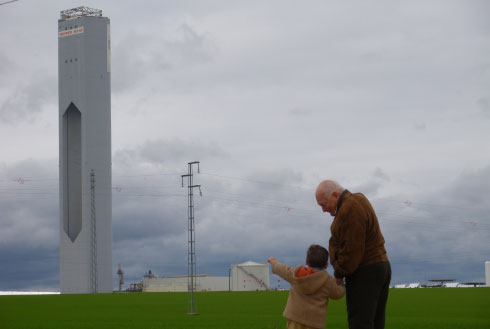 Abengoa
Abengoa
Annual Report 2009
The area of sustainability is both deep and far-reaching. The first formal references to sustainable development appeared in 1987 in the Brundtland Report to the UN. Today, sustainable development is understood as that which meets present needs without compromising the possibilities of future generations meeting their own. It is a concept encompassing three dimensions that are intertwined and that complement each other: the environmental, the social and the economic dimensions. The first of these, and perhaps the one bearing most relevance of late, is the environmental dimension, which refers to the way human and organizational activity generate impact on the environment and ecosystems.
Thus, there is growing social awareness with regards to environmental sustainability, particularly with the problem of climate change, which is giving rise to the enactment of increasingly stringent and more restrictive regulatory frameworks for dealing with the environmental impacts of the business community. A change is therefore underway in the global paradigm, having profound implications at the business level and compelling companies to adapt their strategies and activities. This change has direct effect on the activities of companies since it subjects them to a wide range of risks they must attempt to mitigate:
Among these risks to reputation, we may underscore the following: in the first place, there are reputational risks involved. Brand image may be affected where stakeholders in general and consumers in particular perceive a negative attitude from the company. Sooner rather than later, consumers will include the environmental performance of producing companies as part of the criteria in their purchasing decisions.
What is more, there are regulatory risks associated with the need to adapt the company to new legislative frameworks, with the resulting cost that may make certain activities unfeasible. Along the same lines, there may be a drop in the demand for products and services requiring significant energy consumption or which generate large quantities of emissions.
Lastly, legal risks also take on considerable significance, for tougher legislation may give rise to a greater number of lawsuits due to cases of infringement.
In addition, there are physical risks involved: climate change could generate installations problems leading to serious consequences. For example, flooding may occur in facilities located near the coast; a rise in precipitation in certain regions could exacerbate corrosion problems in facilities that are not specifically equipped to endure frequent rain; desertification of other geographical areas may lead to problems related to plant operation, etc.
Finally, there are other set of risks that are difficult to evaluate. For example, disruptive innovations may arise, involving either technology or new business models linked to combating climate change. These kinds of innovation can bring about marked changes in certain economic sectors, excluding players that have not anticipated the changes from the market. Market changes may also occur in such a way that growing pressure to reduce emissions may give certain geographies an advantage over others due to the natural resources available to them (access to solar radiation, for example), thereby altering the competitive balance: companies located in these geographical locations will boast a of significant competitive edge.

Photo taken by Deiviti Bronzel, for Bioenergía, from the 1st Edition of the Abengoa Sustainability Photography Contest
The basic aim of the policy on sustainability of any organization must be to mitigate and minimize all of these risks through a series of initiatives contributing to sustainable development. Nevertheless, just as these risks surface, so do new business opportunities.
Reputational opportunities: Businesses with proactive approach to climate change will be favored by customers who take these efforts into account. The others will notice the change straight away in their bottom line. Thus, it is advisable to remind those who harbor doubts about the importance of reputational risk of some well-known cases in the past, in which the flow of negative opinion towards a given brand wreaked havoc on profits. Today the commitment to sustainability represents a competitive advantage, but tomorrow it will be a prerequisite for being able to compete. Abengoa, as one of the companies that has proven its commitment to combating climate change from the beginning, thus has the chance to position itself as a point of reference in the area of sustainability.
Regulatory opportunities: Promoting innovation in certain business undertakings that may simultaneously lead to lower costs and a reduction in Greenhouse Gas (GHG) emissions. An example of this would be desalinating plants meeting their electricity needs through wave power (taking advantage of the desalination plant’s proximity to the coast), which will be a considerable competitive advantage as electrical power generation employing this type of technology matures. Likewise, other pursuits, such as zinc and aluminum recycling (Befesa) may increase business activity remarkably: recycling these metals leads to a very significant reduction in CO2 emissions, if compared to the alternative of extracting the material, an option that is not competitive in costs.
Legal opportunities: As the competing companies that fail to strictly abide by the valid laws see their costs surge as a result of environmental lawsuits, organizations that fulfill their commitments are left with the opportunity of becoming more competitive. Furthermore, the mandatory requirement of reducing GHG emissions or the setting up of obligatory blending proportions for biofuels can be seen as an opportunity for Abengoa’s businesses, because many companies will have to turn to clean energy sources to comply with the obligations.
Other opportunities: The innovations that Abengoa is currently pursuing in relation with sustainability (solar energy, sea and ocean power, hydrogen technology, energy efficiency, second-generation biofuels, CO2 capture and valuation, etc.) may become the key businesses of the future.
In short, sustainability policy must help to manage both the risks and the opportunities associated with climate change and sustainability. To achieve this, it is, on the one hand, necessary to know, understand and manage all types of risks, and, on the other, to identify, gauge and manage the potential opportunities, using suitable measurement tools, reporting systems, and improvement plans. Thus, Abengoa maintains a policy of sustainability, as well as an environmental policy that is clearly defined in its internal regulations, a risk management system covering environmental risks, a GHG emission inventory, and specific programs for lowering the emissions of all of the company’s business units. Specifically, we must point out several elements that make Abengoa a point of reference with regards to sustainability and the struggle against climate change:
- Abengoa’s General Department of Sustainability promotes and coordinates all efforts in relation to sustainability and climate change. The mission of the department of Sustainability is to galvanize strategy and guidelines to gear Abengoa businesses towards sustainable development. To this end it participates in the Strategy Committee, which analyzes on a monthly basis the most relevant milestones and the main challenges facing the company. The general department of Sustainability thus acts as a think tank for Abengoa in matters pertaining to climate change, advising the other corporate departments and business units so that decisions are always made in line with Abengoa’s principles on sustainability and climate change:
- Defining and fomenting a sustainability policy as a competitive advantage.
- Including sustainability as an asset in what the company does and how it does it.
- Facilitating the adaptation of Abengoa activities and facilities to regulatory changes.

- The Common Management Systems help to align operational, tactical and strategic decisions with Abengoa’s vision of sustainability and approach to combating climate change. The NOC authorization system enables workers directly involved in a given decision to receive instant feedback.
- CO2emissions inventory is intended to provide an exact picture of the GHG emissions of each company activity in order to assess the situation with regards to competition and to identify options for improvement. It also allows the organization to evaluate its suppliers on the basis of their emissions, as yet another criterion to consider when deciding to purchase. This led each of the business units to set up specific plans for emissions reduction.
- Environmental Sustainability Indicators (ESI), currently under implementation, will enable in-depth analysis of the point above because they integrate another set of environmental variables into business management.
- Constantly informing all the employees on the importance of including environmental variables and combating climate change in the manner in which they perform their duties. Amongst other communication tools, Abengoa uses its internal bulletin and intranet to distribute these messages.
Indeed Abengoa is convinced that the world needs solutions that permit sustainability. In line with this vision, over a decade ago the company decided to focus its growth on creating new technologies that contribute to sustainable development:
- Generating energy from renewable resources.
- Recycling industrial waste, and generating and managing water.
- Creating infrastructures that minimize new investments in emission-generating assets.
- Developing information systems that aid in managing existing infrastructures more effectively.
- Promoting new avenues for development and innovation.
However, Abengoa centers company growth not only on activities contributing towards sustainable development. For some time now, Abengoa’s policy on sustainability has been part of the company’s business commitments and therefore Abengoa also seeks to conduct its activities in a sustainable manner.

Specifically, in the case of lowering Greenhouse Gas emissions, in 2007 Abengoa took the first step with the creation of Zeroemissions, a company that delivers global solutions for climate change through promotion, development and marketing of carbon credits, strategic carbon consultancy, voluntary emissions compensation, and innovative technologies for GHG reduction. The company later created its department of Sustainability. And as part of its strategy for achieving growth, Abengoa is conducting activities involving CO2capture and storage and energy efficiency. All of these lines of action converge upon a common objective, which is none other than halting climate change through a firm commitment to sustainability, integrating this commitment into its strategic approach:
- Abengoa is rethinking its present businesses from the perspective of sustainability, focusing future businesses by taking both environmental and sustainability variables into consideration.
- Abengoa’s desire is not only for its products and services to stay in line with sustainability, but also for them to be created in a sustainable manner, striving for their degree of sustainability to be assured through quantification and validation using transparent instruments that are recognizable to the industry and to society at large.
It must be pointed out that this effort has been in motion for a long time, and, in addition to the emissions inventory, Abengoa is engaged in significant initiatives involving the struggle against climate change:
- Abengoa is listed on the FTSE4GoodIbex sustainability index, and it participates in the Carbon Disclosure Project (CDP).
- Abengoa participates in four carbon funds, with an investment of more than 20 M€:
- FEC. Spanish Carbon Fund (FEC), which invests in projects involving renewable energies, gas destruction, energy efficiency, and solid waste, primarily in Latin America.
- MCCF, Multilateral Carbon Credit Fund. It invests in projects focused on renewable energies, gas destruction, energy efficiency, and solid waste in Europe and Asia.
- FC2E. Spanish Business Fund. It invests in projects with a global range.
- Bio Carbon Fund, Europe and Asia.
- Abengoa has created the Forum on Climate Change through the Focus-Abengoa Foundation. This forum seeks to promote an open platform for research, by means of actions of public debate, presentation and contrasting of ideas and results in relation to renewable energies and climate change. The forum is centered on fields in which, by reason of being the focus of the company’s activities, Abengoa can make significant contributions in the different areas of international, industrial and technological relations, as well as in any other pertinent areas.
- Abengoa took the first initiative of Specific Carbon Training in Spain, holding the first program in 2008. The Carbon Market Specialist course organized by the Focus-Abengoa Forum on Energy and Climate Change, in collaboration with the IETA (International Emissions Trading Association), seeks to train professionals from around the world through a global, integrating approach to carbon markets, enabling them to operate effectively and rigorously on these markets.
- Abengoa aspires for the Palmas Altas Technology Center to be a global model of sustainable building. This worksite is an excellent example of Abengoa’s deep commitment to combating climate change, and hence to sustainable architecture.
- Abengoa has conducted significant activities in the areas of renewable energies, recycling, systems and infrastructure, all of which have helped to prevent the emission of millions of tons of CO2into the atmosphere.
To sum up, with the aim of reaching business goals and fulfilling its commitment to sustainability and the struggle against climate change, Abengoa:
- nvests in research, development and innovation (R&D&i);
- promotes the technologies with the greatest potential; and
- develops the required talent by attracting and retaining the best human resources.
Through the Focus-Abengoa Foundation, the company also allocates human and economic resources to promoting social action policies that contribute to human and social progress.
This guiding philosophy, which drives Abengoa forward in developing innovative solutions for sustainability, has been instilled into the entire organization, and therefore defines the corporate mission and vision.
Mission
Abengoa is a technology company that applies innovative solutions for sustainability in the infrastructure, environmental and energy sectors, bringing long-term value to its shareholders through a management model based on encouraging entrepreneurial spirit, social responsibility, transparency, and rigor.
Vision
To become a global point of reference in developing innovative technological solutions for sustainable development.
At Abengoa, the vision goes far beyond a mere declaration of intent; it involves a truly inspiring guide for making strategic decisions, and thus company growth is based on investment in markets, activities and geographies in which:
- Puede llegar a convertirse en un referente mundial.
- Puede contribuir al desarrollo sostenible.
- La tecnología y la innovación son un componente crítico.
This approach, which is in place at all company levels, is one of Abengoa’s keys to success.
Case Study
Palmas Altas Campus
The new Abengoa headquarters in Seville, inaugurated on September 23, is the first industrial park dedicated to innovation in Andalucia and the largest private technological business complex in southern Spain.
The Palmas Altas Campus (PAC) was designed by Richard Rogers, an architect who worked together with Spanish Vidal and Architectural Associates (Madrid), Juan Fernández Carbonell Studio (Seville), and Agrup Engineering.

Photo taken by Bernabé Lugo Puerto, for Inabensa, from the 1st Edition of the Abengoa Sustainability Photography Contest
This Campus, striving to become a point of reference in sustainable construction, incorporates the latest concepts in sustainability, especially in elements related to the application of state-of-the-art energy saving and efficiency solutions. The complex is thus based on an optimized architectural design and the use of renewable energies in order to minimize the need to employ contaminating energy sources. In this respect, especially worth mentioning are the following elements:
Aspects of construction
- Indoor cooling system: chilled beams.
- Efficient lighting. The building design encourages the use of natural light, enabling the formation of columns of natural light within the building. Regulation of artificial light depending on natural lighting conditions.
- Façade slats for enhancing natural light.
- Compact construction to create a steady-temperature environment that lowers energy consumption.
Renewable Energies
- Trigeneration and parabolic trough collectors: the system produces electrical power, as well as hot and cold water to heat and air-condition the building.
- Outdoor lighting employing a Stirling dish and a fuel cell. Solar energy turns into electricity by means of the Stirling dish and is stored in a fuel cell in the form of hydrogen, utilized at night to provide illumination.
- Photovoltaic solar installation covering and protecting the courtyards located between buildings, supplying 15% of the energy used at PAC.

Photo taken by Eduardo Rituerto García, for Inabensa, from the 1st Edition of the Abengoa Sustainability Photography Contest
Other Aspects
- Active landscaping and the creation of microclimates.
- LEED Platinium Pre-certification, an evaluation by the Green Building Council, a non-profit organization, that promotes the sustainability of buildings.
2009 Milestones
- Development of the second GHG emissions inventory.
- The GHG inventory was declared to be of national interest by the presidency of the Republic of Uruguay.
- Completion of the construction of the Palmas Altas Campus, the new Abengoa headquarters in Seville, representing a model of sustainable building.
- Advancements in the sustainability indicator system (nine environmental factors which Abengoa can act upon) with the aim of conducting in-depth analysis of the environmental impact generated by company activity.
- Beginning of emission reduction planning development, based on the 2008 inventory, for subsequent implementation.
- Abengoa received the Corporate Social Responsibility prize from the Dossier Empresarial economic journal.
- The FTSE Group maintained Abengoa as a member of the FTSE4Good IBEX, the index of socially responsible investments, in its 2009 review.
- As a founding member, Abengoa Solar was a signatory to the Desertec Industrial Initiative project.

Commendation. 1st Edition of the Abengoa Sustainability Photography Contest, submitted by María Márquez-Sánchez Bermejo, of Abener

Commendation. 1st Edition of the Abengoa Sustainability Photography Contest, submitted by Ana Carnal Adrés-Montalvo, of Zeroemissions

Commendation. 1stEdition of the Abengoa Sustainability Photography Contest, submitted by Mª Victoria Sánchez Jiménez, of Abengoa
Abengoa is convinced that the world needs solutions that permit sustainable development